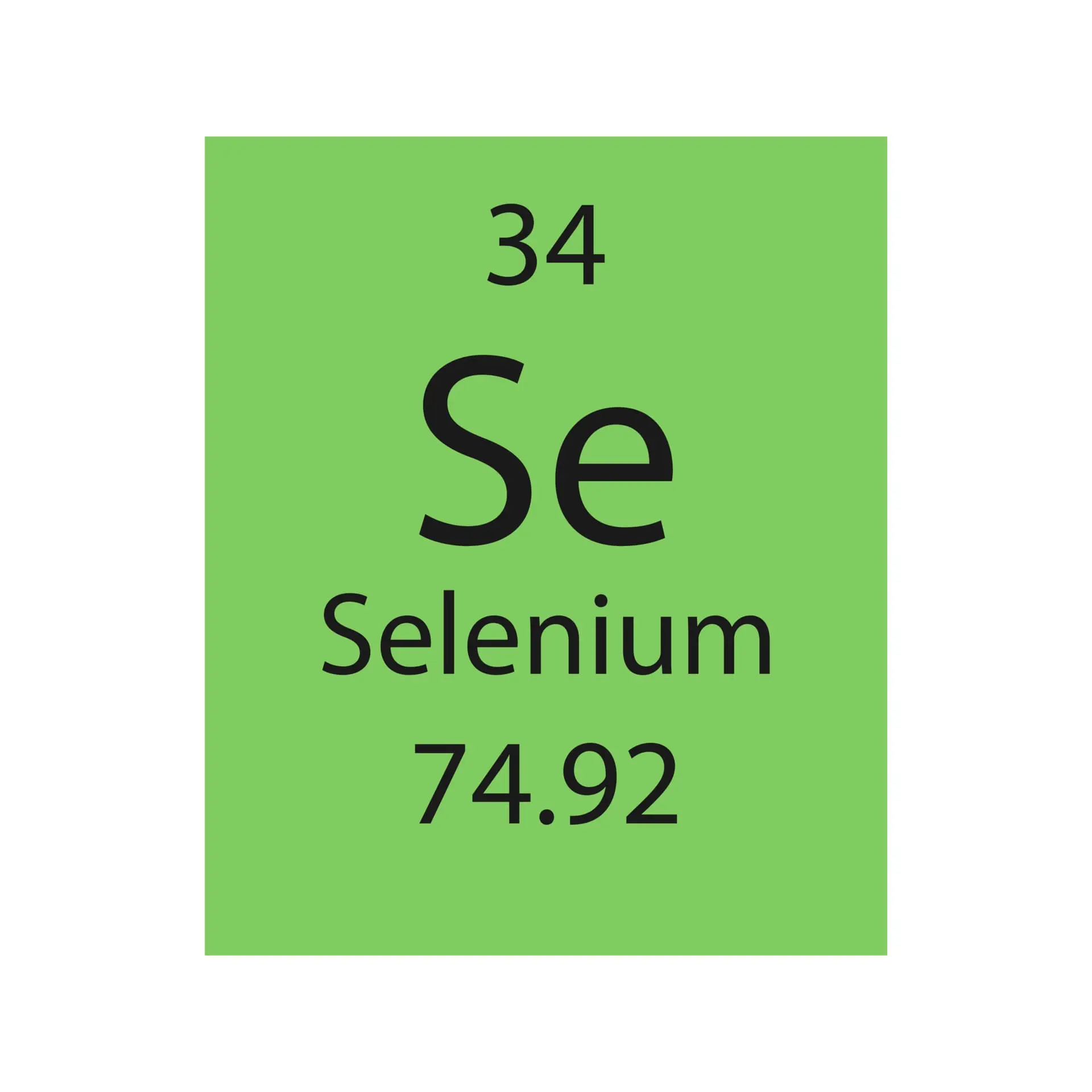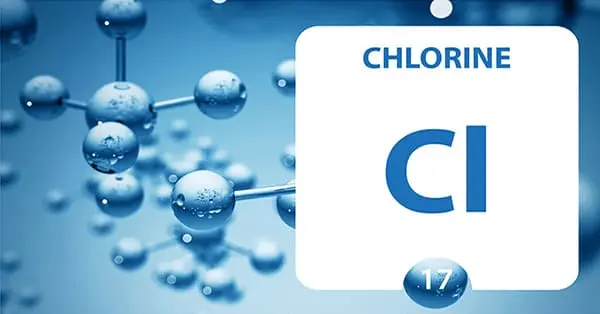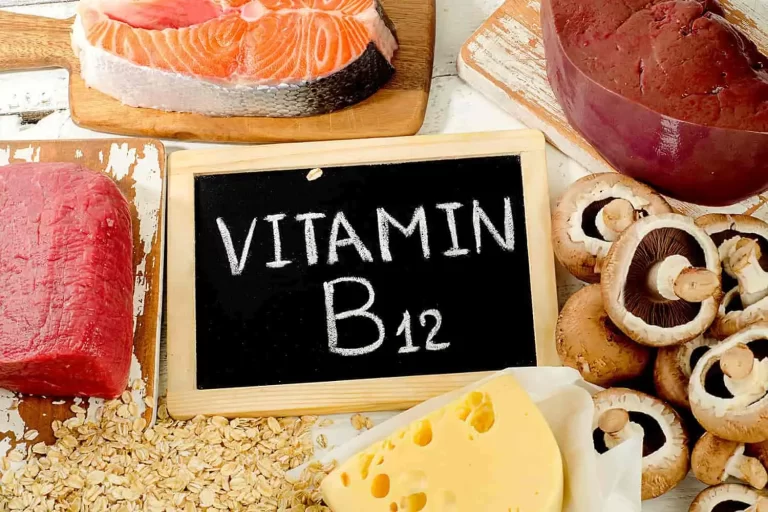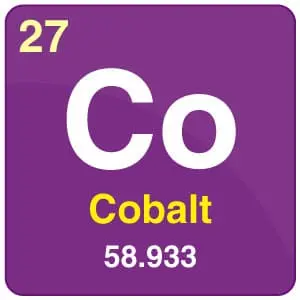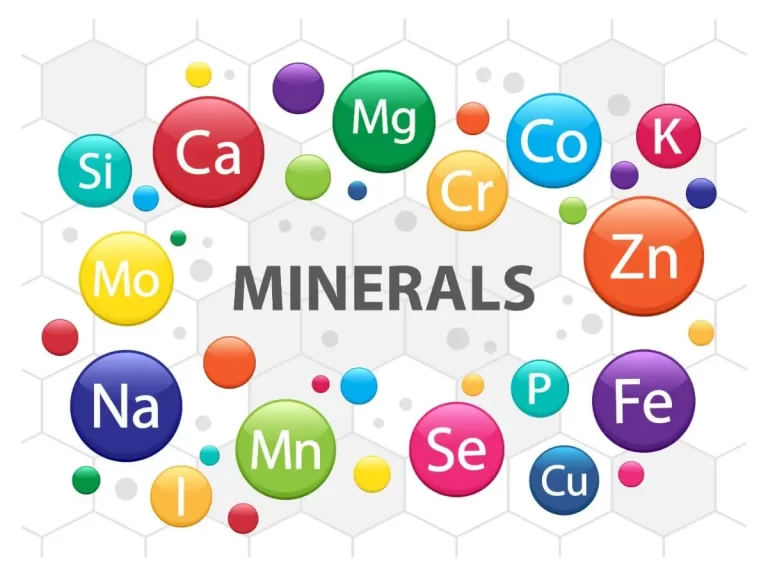Selenium
What is Selenium?
The chemical element selenium has the atomic number 34 and the symbol Se. It is a nonmetal (less frequently regarded as a metalloid) having characteristics halfway between sulfur and tellurium, two elements higher and lower on the periodic table, and it has characteristics with arsenic.
In the crust of the Earth, it is seldom found in its elemental form or as pure ore complexes. In 1817.
Jöns Jacob Berzelius discovered selenium (from the Ancient Greek σελήvη (selḗnē)’moon’). He recognized that the new element shared similarities with the previously found tellurium (named after the Earth).
In metal sulfide ores, selenium can be found partially substituting sulfur. Selenium is commercially generated as a byproduct of these ores’ processing, usually during production.
Selenate or pure selenide-containing minerals are known to exist, however they are uncommon. These days, glassmaking and pigments are the main commercial applications for selenium. Photocells employ the semiconductor selenium.
Silicon semiconductor devices have largely superseded electronics applications, which were formerly significant. A few varieties of DC power surge protectors and one kind of luminous quantum dot still include selenium.
While many species, including humans, require trace quantities of selenium for proper cellular function, even small levels of elemental selenium or selenium salts can be hazardous and result in selenosis.
Several multivitamins, nutritional supplements, baby formula, and other products contain selenium as an ingredient.
It is also a part of the antioxidant enzymes glutathione peroxidase and thioredoxin reductase, which is present in three deiodinase enzymes and indirectly reduces certain oxidized compounds in mammals and certain plants.
Plant species vary in their requirements for selenium; some seem to need quite significant quantities, while others don’t seem to need any at all.
Characteristics
Physical Properties
Depending in part on the temperature change pace, selenium produces several interconvertible allotropes. Selenium is often produced chemically as an amorphous, brick-red powder.
It transforms into a black, vitreous form when quickly melted, which is often marketed commercially as beads.
Black selenium has a complicated and asymmetrical structure made up of polymeric rings that may include up to 1000 atoms each
Brittle and glossy, black selenium dissolves little in CS2. It softens at 50 °C and transforms into gray selenium at 180 °C when heated; the presence of amines and halogens lowers the transition temperature.
Black selenium solutions are converted into the red α, β, and γ forms by changing the solvent’s rate of evaporation, which is typically CS2.
Similar to sulfur, they all feature almost identical puckered cyclooctaselenium (Se8) rings with varied geometric configurations and a somewhat low, monoclinic crystal symmetry.
A ring’s eight atoms are not equivalent—that is, no symmetry operation maps them onto one another—and in the γ-monoclinic form, half of the rings are in one.
Half in one configuration (as well as its mirror counterpart). In the α form, the packing is the densest.
The average Se–Se distance and Se–Se–Se angle in the Se8 rings are 233.5 pm and 105.7°, respectively, depending on the location of the pair of atoms inside the ring. Se6 or Se7 rings may be present in other selenium allotropes.
With a chiral hexagonal crystal structure (space group 152 or 154 depending on the chirality) made up of helical polymeric chains and a Se–Se distance of 237.3 pm and Se–Se–Se angle of 103.1°, gray selenium is the most stable and dense form of the element.
343.6 pm is the minimum distance between chains. Selenium may be turned gray by condensing selenium vapor just below the melting point, slowly cooling molten selenium, or gently heating other allotropes.
Some types of selenium are insulators, one semiconductor exhibiting noticeable photoconductivity is gray selenium.
In contrast to the other allotropes, it cannot dissolve in CS2. It is unaffected by nonoxidizing acids and is resistant to airborne oxidation. With powerful reducing agents, it generates polyselenides. When sulfur is heated gradually, it changes viscosity; this is not the case with selenium.
Isotopes
There are seven isotopes of selenium that exist naturally. Of them, five are stable: 74Se, 76Se, 77Se, 78Se, and 80Se. The most abundant is 80Se, with a natural abundance of 49.6%.
The long-lived primordial radionuclide 82Se, which has a half-life of 9.2×1019 years, is also found in nature.
As a byproduct of nuclear fission, the non-primordial radioisotope 79Se may also be found in trace amounts in uranium ores.
From 64Se to 95Se, there are several unstable synthetic isotopes of selenium; the most stable is 75Se, which has a half-life of 119.78 days, and 72Se, which has an 8.4-day half-life.
The majority of isotopes that are lighter than stable isotopes decay by beta plus to isotopes of arsenic, whereas the heavier isotopes decay via beta minus to isotopes of bromine. The heaviest known isotopes also exhibit some modest neutron emission branches.
| Isotope | Nature | Origin | Half-life |
| 74Se | Primordial | Stable | |
| 76Se | Primordial | Stable | |
| 77Se | Primordial | Fission product | Stable |
| 78Se | Primordial | Fission product | Stable |
| 79Se | Trace | Fission product | 327000 yr |
| 80Se | Primordial | Fission product | Stable |
| 82Se | Primordial | Fission product* | ~1020 yr |
Chemical Compounds
Common oxidation states for selenium compounds include −2, +2, +4, and +6.
Chalcogen Compounds
Two oxides are formed by selenium: selenium trioxide (SeO3) and selenium dioxide (SeO2). Elements of selenium are burned to produce selenium dioxide:
Se + O2 → SeO2
In the gas phase, t is a polymeric solid that generates monomeric SeO2 molecules. When dissolved in water, it yields H2SeO3 or selenous acid. Nitric acid can be used to oxidize elemental selenium in order to directly produce selenium acid:
3 Se + 4 HNO3 + H2O → 3 H2SeO3 + 4 NO
Above 185 °C, selenium trioxide breaks down to dioxide due to thermodynamic instability, in contrast to sulfur, which forms a stable trioxide:
2 SeO3 → 2 SeO2 + O2 (ΔH = −54 kJ/mol)
In a lab setting, sulfur trioxide (SO3) and anhydrous potassium selenium (K2SeO4) react to generate selenium trioxide.
We refer to selenites as selenous acid salts. Among them are sodium selenite (Na2SeO3) and silver selenite (Ag2SeO3)
Selenium disulfide is created when hydrogen sulfide and aqueous selenous acid react:
H2SeO3 + 2 H2S → SeS2 + 3 H2O
The rings of selenium disulfide have eight members. It is roughly composed of SeS2, with other rings, such as Se4S4 and Se2S6, having different compositions.
Selenium disulfide has been utilized as a glass dye, a reducing agent in fireworks, an inhibitor in polymer chemistry, and an antidandruff agent in shampoo. Dehydrating selenic acid, or H2SeO4, which is created when selenium dioxide is oxidized with hydrogen peroxide, can provide selenium trioxide:
SeO2 + H2O2 → H2SeO4
Gold(III) selenate is created when hot, concentrated selenic acid interacts with gold.
Halogen Compounds
Selenium hexafluoride is created when selenium and fluorine combine:
Se8 + 24 F2 → 8 SeF6
In comparison with its sulfur equivalent (sulfur hexafluoride), selenium hexafluoride (SeF6) is more reactive and is a hazardous lung irritant. With differing stoichiometry, the components create selenium tetrafluoride, a laboratory-scale fluorinating agent, instead.
The only stable chlorides are selenium monochloride (Se2Cl2), also chemically similar to disulfur dichloride and maybe better known as selenium(I) chloride, and selenium tetrachloride (SeCl4).
Metastable solutions of selenium dichloride may be made from sulfuryl chloride and selenium (reaction of the elements yields the tetrachloride instead), and form a significant reagent in the synthesis of selenium compounds.
The same stability and structure as the chlorides are recapitulated by the equivalent bromides, all of which are known.
Selenium’s iodides are poorly understood and were long thought to be nonexistent. A small amount of spectroscopic data suggests that.
The lower iodides might develop in bi-elemental solutions including nonpolar solvents, such as carbon tetrachloride, and disulfide, although even these seem to break down in the presence of light.
Certain selenium oxyhalides, such as selenium oxychloride (SeOCl2) and selenium oxyfluoride (SeOF2), have found application as specialized solvents.
Metal selenides
Selenium reacts with other chalcogens to generate hydrogen selenide or H2Se. It is a colorless, poisonous, and highly odorous gas. Not as acidic as H2S, though.
In solution, it ionizes to HSe−. A wide range of compounds, including the minerals used to produce commercial selenium, are formed by the selenide dianion Se2−.
Mercury selenide (HgSe), lead selenide (PbSe), zinc selenide (ZnSe), and copper indium gallium diselenide (Cu(Ga, In) Se2) are examples of illustrative selenides.
Semiconductors are these materials. These selenides are susceptible to hydrolysis when exposed to strongly electropositive metals like aluminum, which can be characterized by the following simplified equation:
Al2Se3 + 6 H2O → 2 Al(OH)3 + 3 H2Se
Polyselenides, or Se2−n, are created when selenium and alkali metal selenides react, and they take the shape of chains and rings.
Other Compounds
Similar to tetrasulfur tetranitride (S4N4), tetraselenium tetranitride, or Se4N4, is an orange, explosive chemical. It may be produced via the interaction of selenium tetrachloride (SeCl4) with [((CH3\3Si)2N]2Se.
Cyanides and selenium combine to form selenocyanates:
8 KCN + Se8 → 8 KSeCN
Organoselenium Compounds
Selenium, notably in the II oxidation state, generates a range of organic compounds. They resemble the equivalent organosulfur compounds structurally.
Selenols (RSeH, analogs of thiols), diselenides (R2Se2, analogs of disulfides), and selenides (R2Se, analogs of thioethers) are particularly prevalent.
Selenomethionine, diphenyl diselenide, and benzeneselenol are examples of selenides, diselenides, and seleniols, respectively.
The selenoxides (formula RSe(O)R), which are intermediates in organic synthesis as demonstrated by the selenium elimination process, are the equivalent of sulfoxide in sulfur chemistry.
Selenoketones, R(C=Se)R, and selenaldehydes, R(C=Se)H, are infrequently encountered, which is in line with trends suggested by the double bond rule.
History
In 1817, Jöns Jacob Berzelius and Johan Gottlieb Gahn made the discovery of selenium (Greek: σελήvη selene, meaning “Moon”).
The two chemists operated a chemical plant that used the lead chamber technique to produce sulfuric acid close to Gripsholm, Sweden. Pyrite samples from the Falun Mine were used to manufacture acid, but the usage of pyrite was abandoned because the samples formed a red solid precipitate in the lead chambers that was thought to be an arsenic compound.
When the red precipitate was burnt, Berzelius and Gahn, who were interested in using the pyrite, noticed that it smelled like horseradish.
There was nothing familiar about this fragrance. arsenic, but tellurium compounds were also found to have a similar smell.
As a result, Berzelius identified this as a tellurium compound in his initial correspondence with Alexander Marcet.
But subsequently, Berzelius reanalyzed the red precipitate since the minerals from the Falun Mine did not include tellurium compounds.
In a second letter to Marcet, published in 1818, he described a newly discovered element that was related to both tellurium and sulfur.
Berzelius named the new element after the Moon due to its resemblance to tellurium, which was named after the Earth.
In 1873, Willoughby Smith showed that the electrical conductivity of grey selenium was altered by light. Its application as a light-sensing cell resulted from this.
Werner Siemens created the first selenium-based commercial items in the middle of the 1870s. Alexander Graham Bell’s photophone, created in 1879, employed a selenium cell.
A proportionate electric current is transmitted by selenium based on the quantity of light that strikes its surface.
Light meters and related gadgets were designed with this effect in mind. Numerous further uses for the semiconductor qualities of selenium were discovered in technology.
Because selenium rectifiers were more efficient than copper oxide rectifiers, they were developed starting in the early 1930s.
These were used in commercial applications until the 1970s when cheaper and even more effective silicon rectifiers took their place. Due to its toxicity to industrial workers, selenium only became known in medicine much later in life.
Animals that have consumed high-selenium plants exhibit signs of toxicity, which is another major veterinary use for selenium. Biochemist Jane Pinsent found the first indications of selenium’s unique biological roles in microbes in 1954.
In 1957, it was shown to be necessary for the survival of mammals. It was discovered to exist in two distinct sets of enzymes in the 1970s.
The identification of selenocysteine in proteins came next. In the 1980s, it was discovered that the codon UGA encodes selenocysteine. First, in bacteria, and later in mammals, the recoding method was figured out.
Occurrence
Selenium is an uncommon mineral that seldom forms excellent crystals; when it does, the crystals are small acicular (hair-like) crystals or steep rhombohedral.
Selenium isolation is frequently hampered by the presence of other substances and elements. Although these minerals are uncommon, selenium may be found in nature in a variety of inorganic forms, such as selenide, selenite, and selenite.
The ubiquitous mineral selenite, which was called for the moon long before selenium was discovered, is really a kind of gypsum (calcium sulfate hydrate), not a selenium mineral, and does not contain any selenite ions.
In sulfide ores of various metals, selenium is typically found as an impurity, taking the place of a small amount of sulfur. The amino acids methyl selenocysteine, selenocysteine, and selenomethionine include selenium in biological systems.
Selenium has a function in these compounds that is similar to that of sulfur. Dimethyl selenide is an additional naturally occurring organoselenium molecule.
Certain plants have the ability to bioconcentrate selenium, and certain soils are rich in the mineral. Selenium is mostly found in soluble forms in soils, such as selenium (selenate), which is comparable to sulfate and is readily leached into rivers by runoff.
Selenium is present in considerable concentrations in ocean water. Normal background levels of selenium in the atmosphere are not more than 1 ng/m3, 1 mg/kg in soil and plants, and 0.5 μg/L in fresh and saltwater.
Among the anthropogenic sources of selenium are the mining and smelting of sulfide ores and the burning of coal.
Production
The most popular method for producing selenium is from selenide found in various sulfide ores, including those of copper, nickel, and lead.
Selenium is a particularly valuable byproduct of electrolytic metal refining; it is extracted from the anode muck in copper refineries. The sludge from the now-discontinued lead chambers of sulfuric acid facilities was another source.
These muds can be purified for selenium using a variety of techniques. But the majority of Refinement of copper or sulfuric acid production yields elemental selenium as a byproduct.
Solvent extraction and electrowinning (SX/EW) production of copper has been producing a growing portion of the global supply of copper since its introduction.
Because only a tiny portion of the selenium in the ore is leached with the copper, this alters the selenium’s availability.
In order to produce selenium for industrial use, selenium dioxide is often extracted from leftovers that are left behind after copper is purified.
The next stage in the common production process for the residue is the oxidation of selenium dioxide with sodium carbonate, which is then combined with water and acidified to yield selenous acid (oxidation step).
Elemental selenium is produced by bubbling sulfurous acid with sulfur dioxide (a reduction step).
A total of 93,000 tonnes of selenium were believed to be in reserves. In 2011, about 2,000 tonnes of selenium were produced globally, mostly in Germany (650 t), Japan (630 t), Belgium (200 t), and Russia (140 t).
Two significant producers are left out of this data: China and the United States. In 2004, there was a notable surge from $4–$5 to $27/lb. Between 2004 and 2010, the price remained comparatively constant at around $30 per pound (in 100-pound batches).
But, in 2011, it rose to $65 per pound. 2010’s consumption was split as follows: 10% went toward agriculture, 10% went toward chemicals and pigments, 30% went toward glass manufacture, and 10% went toward electronics. With 1,500–2,000 tons consumed annually, China is the leading user of selenium.
Applications
Manganese Electrolysis
The incorporation of selenium dioxide lowers the power required to run the electrolysis cells during the manganese electrowinning process. For this reason, China is the country that uses selenium dioxide the most. On average, 2 kilograms of selenium oxide are utilized for every tonne of manganese.
Glass Production
Glassmaking is the primary commercial application of selenium, using up around 50% of the metal. Glass is reddened by chemicals containing selenium.
The iron impurities that give most glass its characteristic green or yellow hues are neutralized by this color.
Mixtures of CdSe and CdS may be used to provide the appropriate red hue for additional applications.
Alloys
In brasses, selenium and bismuth are employed to substitute more hazardous lead. Lead in brass had to be reduced since lead was regulated in drinking water applications, such as the Safe Drinking Water Act of 1974 in the US.
EnviroBrass is the brand name under which the new brass is sold. Selenium, at quantities of around 0.15%, enhances the machinability of steel similarly to lead and sulfur. In copper alloys, selenium improves machinability in the same way.
Lithium–Selenium Batteries
The Li-Se battery, a kind of lithium battery, is among the most promising energy storage technologies available. With its excellent electrical conductivity, the Li-Se battery is a viable substitute for the lithium-sulfur battery.
Solar Cells
In 1876, British scientist William Grylls Adams and his pupil Richard Evans Day created the first solid-state solar cell using selenium as the photoabsorptive layer. Charles Fritts created the first thin-film solar cell a few years prior, utilizing selenium as the photo absorber once again.
Nevertheless, the development of selenium thin-film solar cells slowed down when silicon sun cells became popular in the 1950s.
Because of this, the 5.0% record efficiency that Tokio Nakada and Akio Kunioka established in 1985 was maintained for almost 30 years.
By changing the device structure, IBM researchers set a new record efficiency in 2017 of 6.5%.
After this success, selenium has garnered increased attractiveness as a broad bandgap photoabsorber that may be used with photo absorbers with a smaller bandgap.
However, the primary obstacle presently preventing future efficiency improvements is a significant open-circuit voltage deficit, necessitating the defect-engineering of selenium thin films to increase carrier lifespan.
Utilizing a laser to crystallize selenium is the sole defect-engineering technique that has been studied thus far for selenium thin-film solar cells.
Photoconductors
Thin sheets of amorphous selenium (α-Se) have been used as photoconductors in flat-panel X-ray detectors.
These detectors immediately transform incoming X-ray photons into electric charges by capturing them using amorphous selenium.
Among other semiconductors, selenium has been selected for this application because of a mix of its advantageous technical and physical characteristics.
- The properties of amorphous selenium are uniformity, high vapor pressure, and low melting point. Large-area homogenous films up to 1 mm thick and deposited at a pace of 1-2 µm/min are made possible by these three features. The X-ray picture quality is enhanced by their inherent polycrystalline materials’ homogeneity and absence of grain boundaries. In the meantime, a wide space is necessary for inspecting bags or people.
- Compared to many compound semiconductors that contain heavy metals like lead mercury, or arsenic, selenium is less harmful.
- The electron and hole mobility in the applied electric field is great enough that, in a typical 0.2 mm thick device, about 98% of the electrons and holes created by X-rays are collected at the electrodes without becoming stuck by different defects. As a result, the device’s sensitivity is great and its behavior can be easily explained by straightforward transport equations.
Rectifiers
The usage of selenium rectifiers began in 1933. Most of them have been supplanted by silicon-based technology. Selenium suppressors are preferred over metal-oxide varistors due to their higher energy capacities, with one noteworthy exception being power DC surge prevention.
Other Uses
Modifications have been made to the catalysts used in the vulcanization process to produce rubber using trace quantities of organoselenium compounds.
The electronics industry’s need for selenium is dwindling. Photocopying, photocells, light meters, and solar cells can still benefit from their photovoltaic and photoconductive qualities.
Its usage as a photoconductor in plain-paper copiers was formerly a leading use; however, as more copiers shifted to organic photoconductors in the 1980s, the photoconductor application decreased, although it was a significant end-use.
Blue LEDs were originally made of zinc selenide, but gallium nitride now commands the majority of the market.
The component of cadmium selenide that was crucial to quantum dots was Amorphous selenium sheets are used in solid-state, flat-panel X-ray cameras and xeroradiography to transform X-ray pictures into patterns of charge.
X-ray lasers employ ionized selenium (Se+24) as one of their active media. Although there are some chemical processes that selenium may catalyze, its toxicity prevents it from being employed extensively.
One or more selenium atoms can be added to sulfur to aid in X-ray crystallography’s single-wavelength anomalous dispersion phasing and multiple-wavelength anomalous dispersion phasing.
Many photographic manufacturers sell selenium as a toner, which is used for toning photographic prints.
The tonal range of black and white photos is enhanced and intensified with selenium, which also makes prints more durable.
A gamma source for industrial radiography is 75Se. Certain anti-dandruff shampoos, such as Selsun and Vichy Dereos brands, include selenium in the form of selenium disulfide.
Pollution
Certain aquatic systems may be impacted by selenium contamination, which can be brought on by human activities including industrial operations and farm runoff.
Although selenium has the potential to affect human health, those who eat more fish tend to be healthier than those who eat less, suggesting that selenium pollution is not a big health risk for humans.
High tissue selenium concentrations in fish can cause significant physiological effects. Selenium-affected fish may have gill lamellae that enlarge, which prevents blood flow and oxygen diffusion via the gills.
The binding of selenium to hemoglobin further reduces respiratory capacity. Additional issues include cataracts, enlarged heart chambers, deteriorated ovarian egg follicles, liver tissue deterioration, and fluid buildup in the head and body cavities.
Fish fetuses deformed by selenium frequently have difficulties breathing or eating, and their fins or spines are frequently distorted.
Even if adult fish are unable to create viable offspring, they may nevertheless seem healthy.
Aquatic environments cause selenium to bioaccumulate, resulting in greater quantities in living things than in the nearby water.
When water concentrations are between 0.5 and 0.8 μg Se/L, zooplankton may concentrate organoselenium compounds by a factor of over 200,000.
Phytoplankton is better capable of bioaccumulating inorganic selenium than zooplankton. By a ratio of three thousand, phytoplankton may concentrate inorganic selenium.
Along the food chain, as predators eat species high in selenium, there is further concentration through bioaccumulation.
For sensitive fish and aquatic birds, a water concentration of 2 μg Se/L is advised to be regarded as extremely dangerous.
Parental selenium toxicity can result in selenium toxicity that may last for several generations and pass on to progeny through the egg.
Mallard ducks cannot reproduce when their food contains 7 μg Se/L. Numerous benthic invertebrates are able to withstand dietary selenium doses of up to 300 μg/L.
Depending on the species present, bioaccumulation of selenium in aquatic habitats results in fish deaths. A small number of species, nonetheless, have been seen to withstand these occurrences and the elevated selenium.
Additionally, it has been proposed that the detrimental effects of selenium on fish may vary depending on the season.
Water systems may get contaminated with selenium anytime fresh agricultural runoff passes through arid areas.
Selenates and other naturally occurring soluble selenium compounds are leached into the water by this process, and when the water evaporates, they may concentrate in wetlands.
Waterways can also get contaminated with selenium due to leaching from coal flue ash, metal smelting, crude oil processing, and landfills.
Fish and other oviparous species, such as marsh birds and fish, have been shown to develop congenital abnormalities due to elevated selenium levels in rivers. In oviparous animals, increased methylmercury levels in the diet can exacerbate the negative effects of selenium poisoning.
Cases
Nineteen fish species were eradicated from Belews Lake, North Carolina, as a result of 150–200 μg Se/L of effluent that was released from a Duke Energy coal-fired power station between 1974 and 1986.
Selenium in agricultural irrigation drainage poisoned thousands of fish and waterbirds in the Kesterson National Wildlife Refuge in California.
Biological Role
Selenium is a micronutrient that is vital to mammals while being harmful in high concentrations. Selenium is a bystander mineral that may occasionally be found in hazardous amounts in plants’ feed.
While certain plants may store selenium in order to protect themselves from animal consumption, others, like locoweed, really need it and their development is a sign the soil has it.
Selenium is found in the rare amino acids selenium cytosine and seleniomethionine. Selenium is a trace element that is necessary for the reduction of antioxidant enzymes in humans, including glutathione peroxidases and some forms of thioredoxin reductase that are present in animals and certain plants.
Although thioredoxin reductase is an enzyme that is present in all living things, not all plant forms of the enzyme require selenium.
Certain processes that eliminate reactive oxygen species, such as hydrogen peroxide and organic hydroperoxides, are catalyzed by the glutathione peroxidase family of enzymes (GSH-Px):
2 GSH + H2O2—-GSH-Px → GSSG + 2 H2O
The iodothyronine deiodinases are the subfamily of deiodinase enzymes that use selenium as the otherwise uncommon amino acid selenocysteine.
Evolution in Biology
The thyroid gland and every cell that uses thyroid hormone use selenium, which is a cofactor for three of the four known types of thyroid hormone deiodinases, which activate and then deactivate various thyroid hormones and their metabolites.
(The only enzyme that does not utilize selenium is iodotyrosine deiodinase, which breaks down the last components of thyroid hormone.)
Hashimoto’s disease, in which the body attacks its own thyroid cells as foreign invaders, may be inhibited by selenium.
A 21% decrease in TPO antibodies has been seen when 0.2 mg of selenium is consumed through diet. The consequences of mercury poisoning are lessened by increased dietary selenium, however, this impact is limited to low to moderate mercury concentrations.
There is evidence that the permanent inhibition of selenoenzymes, which are necessary to stop and reverse oxidative damage in the brain and endocrine tissues, is one of the molecular causes of mercury poisoning. Bluefin tuna blood contains the selenium-containing substance selenoneine.
The development of the amino acid selenocysteine began around three billion years ago, driven by bacterial selenoprotein families. In bacteria, archaea, and eukaryotes, selenium is integrated into many prokaryotic selenoprotein families as selenocysteine.
Selenoprotein peroxiredoxins shield bacterial and eukaryotic cells from oxidative damage. The deiodinases of eukaryotic cells and the selenium protein families of GSH-Px appear to have bacterial evolutionary origins.
Species as varied as fish, chickens, sea urchins, diatoms, and green algae include the selenocysteine-containing form. Glutathione and thioredoxin are two tiny reducing compounds that are mediated by selenium enzymes.
One class of compounds containing selenium, the glutathione peroxidases) use glutathione to repair damaged peroxidized cell membranes and eliminate peroxide.
Reduced thioredoxin, a dithiol that acts as an electron source for peroxidases, is produced by another selenium-bearing enzyme called thioredoxin reductase, which is present in various plants and animals.
It is also the precursor of ribonucleotide reductase, an essential reducing enzyme that converts RNA precursors into DNA precursors.
Some terrestrial mineral-poor areas may have been deficient in trace elements such as selenium, vanadium, magnesium, copper, and zinc, which are involved in the activities of GSH-Px and superoxide dismutase enzymes.
While some terrestrial creatures lost part or all of their selenoproteomes, marine organisms maintained and occasionally increased them.
These results imply that selenium usage is supported by aquatic species, with the exception of vertebrates, whereas the use of this trace element is decreased in terrestrial settings.
The thyroid glands of vertebrates and marine fishes have the maximum iodine and selenium concentration.
Freshwater and terrestrial plants began to gradually enhance the synthesis of “new” endogenous antioxidants, such as tocopherols, flavonoids, ascorbic acid (vitamin C), and polyphenols, starting around 500 million years ago.
A handful of them first emerged in the fruits and flowers of angiosperm plants within the last 50 and 200 million years.
In actuality, the majority of the antioxidant pigments seen in angiosperms—the predominant class of plants today— evolved in the late Jurassic.
Another class of eukaryotic selenoenzymes consists of the deiodinase isoenzymes. Deiodinases are implicated in thyroid hormone control, contributing to the protection of thyrocytes against injury by H2O2 generated for thyroid hormone production.
Mammalian GSH-Px enzymes gave rise to novel selenoproteins around 200 million years ago.
Nutritional Sources of Selenium
Meat, nuts, grains, and mushrooms are good sources of dietary selenium. The richest dietary source is Brazil nuts (although this depends on the soil, as the nut itself doesn’t need significant concentrations of the element).
For adults and teens, the Recommended Dietary Allowance (RDA) for selenium is 55 µg per day. There are several kinds of dietary supplements that include selenium, such as multi-vitamins and mineral supplements, which usually provide 55 or 70 µg per serving.
Supplements containing just selenium usually include 100 or 200 µg per serving. The US Food and Drug Administration (FDA) released its final regulation requiring minimum and maximum selenium levels in baby formula in June 2015. It is estimated that the human body has 13–20 mg of selenium.
Indicator Plant Species
Because they need high selenium levels to survive, several plant species are thought to be markers of high soil selenium concentration. Astragalus species, prince’s plume, woody asters, and false goldenweed are the primary selenium indicator plants.
Detection in Biological Fluids
To monitor excessive environmental or occupational exposure, establish a diagnosis of poisoning in hospitalized patients, or look into a possible instance of lethal overdose, selenium levels can be evaluated in blood, plasma, serum, or urine.
Certain analytical methods can differentiate the element’s organic and inorganic forms. Before being eliminated in the urine, the body converts most organic and inorganic forms of selenium into monosaccharide conjugates or senosugars.
Selenothionine taken orally once a day by cancer patients may result in very elevated selenium concentrations in their plasma and urine.
Toxicity
Even while selenium is a necessary trace element, too much of it can be harmful. Selenosis may result from daily intakes above the Tolerable Upper Intake Level of 400 micrograms.
The main sources of information for this 400 µg Tolerable Upper Intake Level are two studies conducted on the same five Chinese patients in 1986 and 1992, both of whom had overt indications of selenosis.
The 1992 study indicated that 400 micrograms per day should be avoided, although the maximum acceptable dietary selenium consumption was determined to be about 800 micrograms per day (15 micrograms per kilogram body weight).
Generating an imbalance of nutrients in the diet and complying with statistics from other nations. Selenium poisoning has been reported in Chinese corn eaters who consumed maize grown in rocky coal (carbonaceous shale), which is exceptionally high in selenium.
The highest quantity of selenium found in coal ever measured, up to 9.1%, was found in this particular coal.
Selenosis can cause neurological damage, gastrointestinal problems, hair loss, nail sloughing, exhaustion, and a garlic-like smell to one’s breath. Seleniosis that is too severe might result in mortality, pulmonary edema, or liver cirrhosis.
Due to their limited bioavailability, most metallic selenides and elemental selenium have comparatively modest toxicities.
In comparison, selenates and selenites are extremely poisonous and operate as oxidants in a manner akin to that of arsenic trioxide. Humans can safely consume between 2400 and 3000 micrograms of selenite per day at a chronic hazardous dosage.
Hydrogen selenide is a very poisonous, corrosive gas. Additionally, chemical molecules containing selenium include dimethyl selenide, selenomethionine, selenocysteine, and methyl selenocysteine.
These compounds are hazardous in high quantities and have a high bioavailability.21 polo horses passed away on April 19, 2009, just before a United States Polo Open match.
Three days later, a compounding pharmacy issued a statement in which they said that one of the elements in a compounded vitamin/mineral supplement that the horses had received was produced improperly, resulting in an inappropriate dose for them.
Selenium concentrations were found to be 10–15 times higher in blood samples and 15–20 times higher in liver samples when the inorganic component levels in the supplement were analyzed. It was later shown that selenium was the causative agent.
Selenium is poisonous at excessive levels yet essential for survival in fish and other species. The ideal selenium content for salmon is around one microgram per gram of total body weight.
Young salmon perish from shortage well below that level and toxic excess far above it. The legal limit (permissible exposure limit) for selenium in the workplace, as established by the Occupational Safety and Health Administration (OSHA), is 0.2 mg/m3 during an 8-hour workday.
An eight-hour workday is considered to have a Recommended Exposure Limit (REL) of 0.2 mg/m3, according to the National Institute for Occupational Safety and Health (NIOSH). Selenium poses an urgent risk to life and health at 1 mg/m3.
Deficiency
Patients receiving complete parenteral nutrition, individuals with highly reduced intestinal function, and elderly patients (over 90) are at risk for selenium insufficiency.
Additionally, those who depend on food produced in soil lacking in selenium are vulnerable. Selenium levels in New Zealand soil are low, yet locals have not shown any negative health impacts.
Low levels of selenium (less than 60% of normal) in brain and endocrine tissues are indicative of selenium insufficiency.
This condition only arises when low selenium levels are combined with other stressors, such as excessive mercury exposure or increased oxidative stress due to vitamin E deficiency.
Vitamin E and iodine are two examples of nutrients with which selenium interacts. Selenium deficiency’s impact on health is still unknown, especially when it comes to Kashin-Beck’s illness. Additionally, selenium interacts with copper and zinc among other minerals.
Zinc levels should be examined in treatment situations where high dosages of selenium supplements may disrupt the zinc: copper ratio and cause a drop in zinc in pregnant animals.
These interactions need to be confirmed by more research. Certain animal species may be deficient in selenium unless it is supplied by food or injection in areas (such as certain parts of North America) where low soil selenium levels result in low concentrations in the plants.
In particular, ruminants are vulnerable. Generally speaking, ruminants absorb less dietary selenium than other animals do, and they absorb less from forages than from grain.
Because cyanide is emitted from particular forages, such as some kinds of white clover that contain cyanogenic glycosides, ruminants grazing those forages may require more selenium.
Glutathione peroxidases are inactivated by the cyanide acting on the glutathione molecule, and aglycone is produced by glucosidase activity in the rumen.
Both vitamin E and selenium may be injected into neonate ruminants who are susceptible to white muscle disease; certain WMD myopathies react solely to vitamin E, while others only to selenium.
Health Effects
Numerous clinical trials and epidemiological studies on people have examined the relationship between selenium consumption and cancer.
As an antioxidant, selenium may have a chemopreventive effect on cancer risk and may also stimulate the immune system.
When taken in greater quantities than usual, it results in cell death. At lower concentrations, the body utilizes it to make antioxidant selenoproteins. Iodine and selenium are closely related, and selenium affects thyroid function.
The three thyroid hormone deiodinases require selenium as a cofactor in order to activate and deactivate different thyroid hormones and their metabolites.
The effect of isolated selenium insufficiency in inducing autoimmune responses in the thyroid gland during Hashimoto’s disease is now being studied. However, in an instance of combined iodine and selenium insufficiency, it was demonstrated that the deficiency of selenium protected the thyroid.
FAQ
What is selenium used for?
Selenium is a necessary component of several enzymes and proteins known as selenoproteins, which aid in the synthesis of DNA, guard against infections and damage to cells, and are also involved in reproduction and thyroid hormone metabolism.
What is selenium in the human body?
Nutritionally necessary for human nutrition, selenium is a component of over twenty selenoproteins involved in DNA synthesis, thyroid hormone metabolism, reproduction, and defense against infection and oxidative stress.
Is selenium good to take daily?
When used orally: Selenium is probably safe at short-term dosages of less than 400 mcg per day. However, using selenium in large amounts or over an extended period of time may be dangerous. The risk of selenium poisoning can rise with daily dosages of more than 400 mcg.
Which food has the highest selenium?
One of the finest places to get selenium is from Brazil nuts. An ounce is around six to eight nuts or 544 micrograms.
Is selenium good for your hair?
Selenium antioxidants aid the body’s defense against free radicals, which damage hair follicles and promote early aging. Selenium effectively helps you maintain healthy hair development as a result of removing these free radicals.
What is the deficiency of selenium in the body?
A lack of selenium may raise the risk of a number of illnesses, such as degenerative diseases, cardiovascular disease, infertility, and cognitive decline, according to research.
Is selenium the same as vitamin E?
These findings showed that selenium and vitamin E had differing antioxidant capacities: vitamin E acts on the biomembrane, whereas selenium operates in the form of Se-dependent glutathione peroxidase (GPX) in the cytoplasm; vitamin E inhibits lipid peroxidation more efficiently than selenium, whilst selenium prevents …

